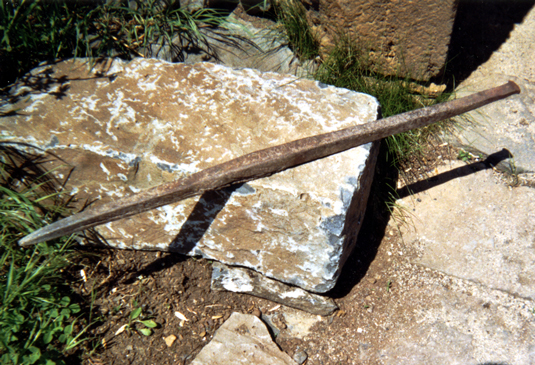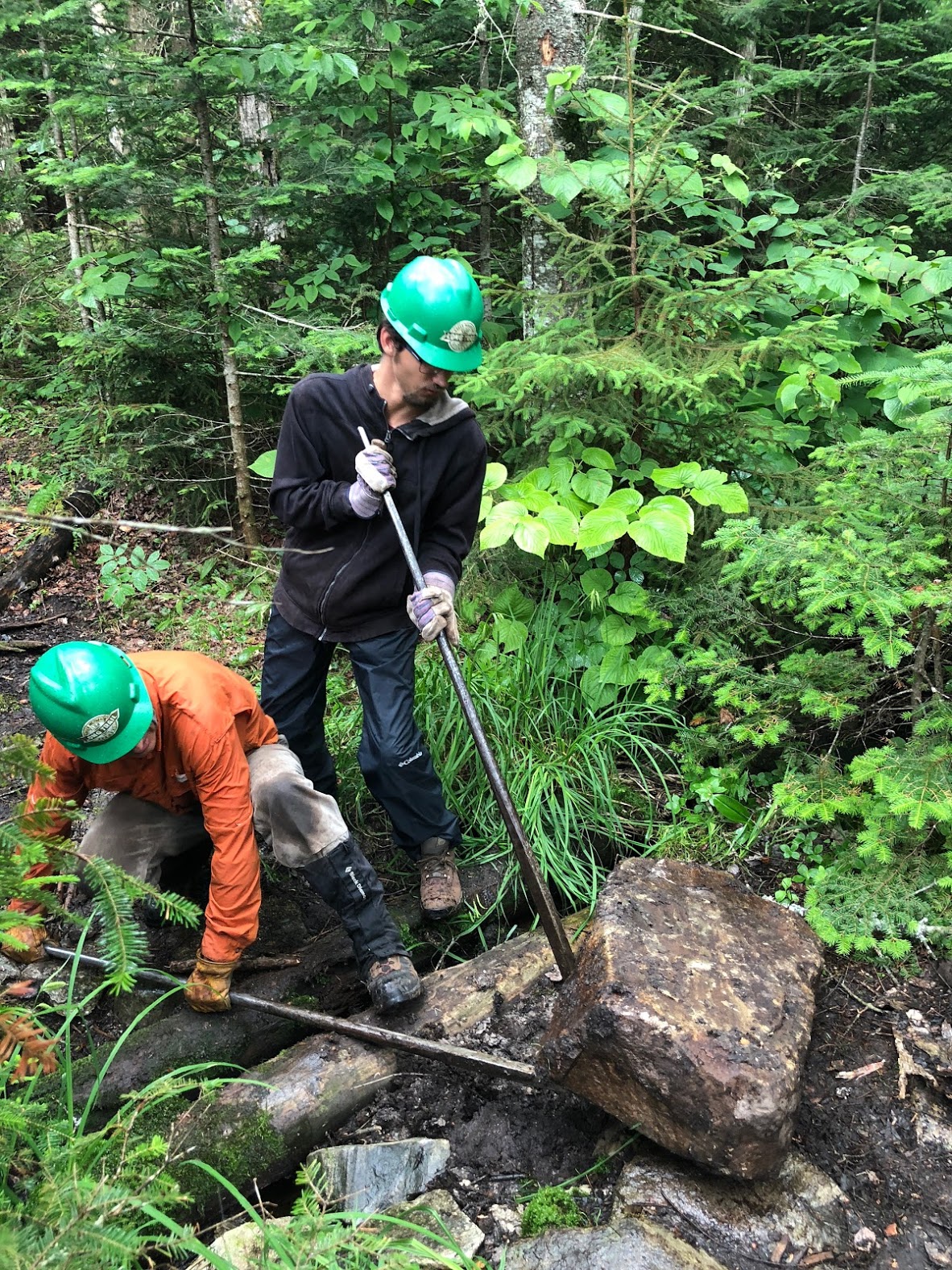Digging Bar on:
[Wikipedia]
[Google]
[Amazon]
 A digging bar is a long, straight metal bar used for various purposes, including as a
A digging bar is a long, straight metal bar used for various purposes, including as a
 Common uses of digging bars include breaking up clay, concrete, frozen ground, and other hard materials, moving or breaking up tree roots and obstacles, and making holes in the ground for fence posts. They are often used where space would not allow the use of a
Common uses of digging bars include breaking up clay, concrete, frozen ground, and other hard materials, moving or breaking up tree roots and obstacles, and making holes in the ground for fence posts. They are often used where space would not allow the use of a
File:Diggingbar.jpg, Bar with wedge and blunt end
File:Spud (PSF).png, Bark spud
File:Hop bars.jpg, Hop bars
File:spudbar3a.jpg, Spud bar
 A digging bar is a long, straight metal bar used for various purposes, including as a
A digging bar is a long, straight metal bar used for various purposes, including as a post hole digger
A post hole clam-shell digger, also called post hole pincer or simply post hole digger, is a tool consisting of two articulated shovel-like blades, forming an incomplete hollow cylinder about a foot long and a few inches wide, with two long hand ...
, to break up or loosen hard or compacted materials such as soil, rock, concrete and ice or as a lever
A lever is a simple machine consisting of a beam or rigid rod pivoted at a fixed hinge, or ''fulcrum''. A lever is a rigid body capable of rotating on a point on itself. On the basis of the locations of fulcrum, load and effort, the lever is div ...
to move objects. Known by other names depending on locale, structural features and intended purpose such as a hop bar or crowbar in Britain, Australia and New Zealand, and slate bar, shale bar, spud bar, pinch point bar or San Angelo bar in North America, or just a bar. In Hawaii
Hawaii ( ; haw, Hawaii or ) is a state in the Western United States, located in the Pacific Ocean about from the U.S. mainland. It is the only U.S. state outside North America, the only state that is an archipelago, and the only stat ...
, a similar, traditional wooden device known as an ''‘o‘o stick'' is used as a digging bar in groundbreaking
Groundbreaking, also known as cutting, sod-cutting, turning the first sod, or a sod-turning ceremony, is a traditional ceremony in many cultures that celebrates the first day of construction for a building or other project. Such ceremonies are o ...
ceremonies. Not to be confused with a curved crowbar, which is designed to provide leverage rather than to dig.
Uses
 Common uses of digging bars include breaking up clay, concrete, frozen ground, and other hard materials, moving or breaking up tree roots and obstacles, and making holes in the ground for fence posts. They are often used where space would not allow the use of a
Common uses of digging bars include breaking up clay, concrete, frozen ground, and other hard materials, moving or breaking up tree roots and obstacles, and making holes in the ground for fence posts. They are often used where space would not allow the use of a pickaxe
A pickaxe, pick-axe, or pick is a generally T-shaped hand tool used for Leverage (mechanics), prying. Its head is typically metal, attached perpendicularly to a longer handle, traditionally made of wood, occasionally metal, and increasingly ...
.
Materials and construction
The ends of a digging bar are shaped for various purposes. Typically, each end has a different shape so as to provide two different tool functions in one tool. Common end shapes include: * Blunt — a broad, blunt surface for tamping. * Point — for breaking hard materials and prying. * Wedge — an unsharpened blade for digging, breaking and prying. A San Angelo bar has a wedge at one end. * Chisel — a sharpened blade for cutting roots, digging and prying. A pinch point bar has a chisel at one end. Bars are typically long and weigh . They are usually made entirely of cylindrical or hexagonal forged steel with a diameter of approximately . Chisel and wedge ends typically have a blade width measuring . Blunt ends typically have a diameter of .Variants
Bark spud
Log-peeling spuds are used to remove the bark from logs. These spuds typically have a wooden or steel handle of length to over . This tool is also called a Bark spud or a barking iron.Hop bar
A hop bar (also Hop pitcher) is used to make holes in the ground for hop poles, or more long with a heavy, bulbous spike at the digging end.Ice spud
Fishing through holes in ice is common in many parts of the world. One of the earliest methods of cutting these holes was to use a device variously known as an ice spud or ice chisel. Many chisel variations exist, including jagged teeth, skewed edges, and different grind angles and chisel widths. Early ice spuds (before about 1925) often had wooden handles and a steel chisel fixed with a tang and collar or socket, similar to a carpenter's chisel. Ice spuds are still carried by many ice fishermen as a means to test ice thickness and safety; a single forceful thrust of the ice spud will often penetrate unsafe ice.Lining bar
A lining bar is used to shift the alignment of railroad tracks, to manipulate some types of railroad track jacks, to "nip up" or lift ties and rails, and as a digging tool. Lining bars have a tapered form. They often have a square cross section between one and 1-1/2 inches at one end. They may have a pyramidal, wedge, or pinch point. They transition to a tapered round cross section 12 to 18 inches from the point. The handle end may terminate in a ball or may be cut off squarely at 5/8 to 3/4 inch diameter. They are made of forged steel and may be from five to six feet long. Lining bars may also be called jack bars, jack handles, or crowbars in North American railroad jargon.Spud bar
A spud bar has a chisel at one end that is intended for removing material through a chipping or shaving action. In theBritish Isles
The British Isles are a group of islands in the North Atlantic Ocean off the north-western coast of continental Europe, consisting of the islands of Great Britain, Ireland, the Isle of Man, the Inner and Outer Hebrides, the Northern Isles, ...
these typically have a narrow, unsharpened chisel point at one end and a point at the other end, with diameters up to about . Some have plastic grips on the shaft and some have wider chisel ends, or "rakes", for specific jobs such as removing old shingles
Shingles, also known as zoster or herpes zoster, is a viral disease characterized by a painful skin rash with blisters in a localized area. Typically the rash occurs in a single, wide mark either on the left or right side of the body or face. ...
and tar paper
Tar paper is a heavy-duty paper used in construction. Tar paper is made by impregnating paper or fiberglass mat with tar, producing a waterproof material useful for roof construction. Tar paper is distinguished from roofing felt, which is impreg ...
.
References
{{Reflist Mechanical hand tools